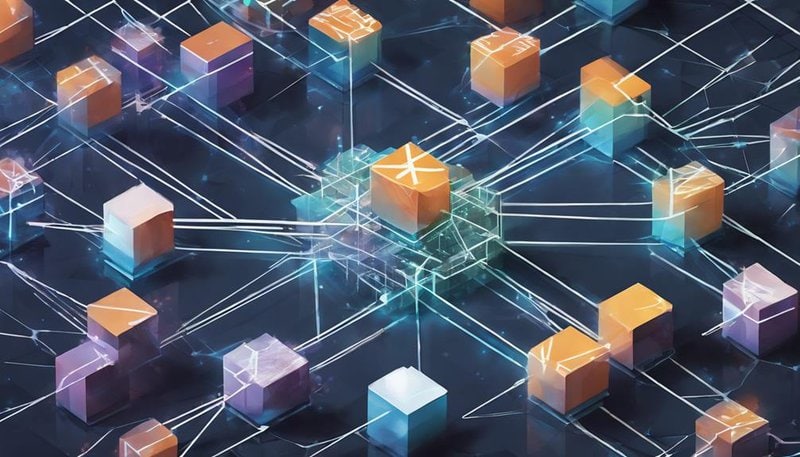How NFTs Can Benefit From Blockchain Scalability Solutions

The benefits of NFTs with blockchain scalability solutions include:
- Enhanced transaction speeds
- Cost efficiency
- Transformative landscape for the NFT market.
The Rise of NFTs in Digital Economy
In the rapidly evolving digital economy, NFTs have emerged as a groundbreaking technology revolutionizing the way we perceive and interact with digital assets. Digital collectibles, once limited to images or videos, are now being transformed into unique, ownable items through the use of Non-Fungible Tokens (NFTs). These tokens adhere to specific token standards, such as ERC-721 and ERC-1155, which ensure the uniqueness and indivisibility of each digital collectible.
By embracing token standards, NFTs have unlocked a new realm of possibilities for creators and consumers alike. Artists can now tokenize their work, providing proof of ownership and scarcity in the digital world. Collectors can confidently purchase and trade these digital assets, knowing that their ownership is securely recorded on the blockchain.
This shift towards tokenizing digital collectibles not only adds value to virtual items but also opens up avenues for new forms of creativity and expression. As NFTs continue to gain momentum, they're reshaping the digital economy by bridging the gap between physical and digital ownership.
Understanding Blockchain Scalability Challenges
Amidst the rapid expansion of blockchain technology, the scalability challenges it faces have become a focal point of discussion and innovation. As you delve into the intricate world of blockchain scalability, it's crucial to grasp the fundamental hurdles that impede its seamless growth.
Here are some key points to consider:
- Scalability Trade Offs: The intricate balance between decentralization, security, and scalability poses a significant challenge for blockchain networks. Striking the right equilibrium without compromising on any of these crucial aspects is a complex task.
- Network Congestion: With the surge in blockchain adoption, network congestion has emerged as a pressing issue. The limited throughput of many blockchain networks often leads to delays and increased transaction costs during times of high activity.
- Performance Bottlenecks: Identifying and overcoming performance bottlenecks is essential for enhancing blockchain scalability. These bottlenecks can arise from various sources, such as inefficient consensus mechanisms or storage limitations.
Understanding these scalability challenges is paramount in paving the way for the implementation of effective solutions that can propel blockchain technology towards a more scalable and efficient future.
Layer 2 Solutions for NFT Scalability

As you navigate the intricacies of blockchain scalability challenges, a promising avenue for addressing NFT scalability lies in exploring Layer 2 solutions. These solutions aim to enhance the scalability of NFT platforms by processing transactions off the main Ethereum chain, increasing efficiency and reducing congestion. One key benefit of Layer 2 solutions is their ability to significantly lower transaction costs and speed up processing times, making NFTs more accessible and functional for users.
| Interoperability Solutions | Decentralized Governance |
|---|---|
| Interoperability solutions aim to enhance the seamless interaction between different blockchains, allowing NFTs to move across various platforms effortlessly. | Decentralized governance ensures that NFT platforms are governed by the community, promoting transparency, fairness, and inclusivity in decision-making processes. |
| These solutions facilitate the exchange of NFTs across diverse ecosystems, expanding their utility and reach in the digital space. | By empowering users to participate in platform governance, decentralized governance fosters a sense of ownership and responsibility among community members. |
| By fostering collaboration and compatibility between blockchain networks, interoperability solutions pave the way for a more interconnected NFT ecosystem. | Decentralized governance models prioritize the input and interests of stakeholders, creating a democratic framework for decision-making within NFT platforms. |
Sharding: A Scalability Solution for NFTs
Sharding emerges as a compelling scalability solution for NFTs, revolutionizing the way transactions are processed on blockchain networks. By breaking the blockchain network into smaller segments called shards, several benefits can be realized:
- Enhanced Scalability: Sharding allows blockchain networks to handle a larger number of transactions simultaneously, improving overall network throughput and performance.
- Increased Efficiency: With sharding, transactions can be processed in parallel across different shards, reducing congestion and bottlenecks within the network.
- Improved Security: Sharding enhances the security of blockchain networks by distributing the validation of transactions across multiple shards, making it more difficult for malicious actors to compromise the system.
Implementing sharding in blockchain networks can lead to significant advancements in scalability, making it a promising solution for the future of NFTs and other decentralized applications.
Impact of Scalability on NFT Transaction Costs

Considering the advancements in blockchain scalability, the impact of this evolution on NFT transaction costs becomes increasingly significant. With the ability to process a higher volume of transactions more quickly, blockchain scalability solutions play a crucial role in reducing costs and increasing efficiency within the NFT ecosystem. By enhancing transaction throughput and lowering fees, scalability solutions pave the way for broader adoption of NFTs by making them more accessible to a wider audience.
| Benefits of Scalability for NFT Transaction Costs | Description |
|---|---|
| Reduced Fees | Lower transaction costs for users |
| Faster Transaction Processing | Quick and efficient NFT exchanges |
| Increased Accessibility | More people can participate |
| Enhanced Market Liquidity | Improved trading opportunities |
| Scalability as a Competitive Advantage | Staying ahead in the NFT market |
Embracing scalability solutions not only benefits NFT creators and collectors but also fosters a more vibrant and dynamic marketplace for digital assets. By optimizing transaction costs, scalability is instrumental in propelling the NFT space towards sustainable growth and widespread adoption.
Enhancing NFT Market Efficiency With Blockchain
Boosting the NFT market efficiency through blockchain technology can be a game-changer for creators like you. Experience faster transaction speeds and reduced fees, empowering you to engage more seamlessly in the world of digital assets.
With improved efficiency, your creations can reach a broader audience, driving higher value and recognition for your work.
Improved Transaction Speed
Enhancing transaction speeds on the blockchain can significantly boost the efficiency of the NFT market.
- Faster transactions lead to quicker trades and increased market liquidity.
- Increased throughput allows for a higher volume of NFT transactions to be processed simultaneously.
- Improved transaction speed enhances the overall user experience, making buying and selling NFTs more seamless and enjoyable.
Lower Fees for Creators
Lowering fees for creators can revolutionize the NFT market's efficiency by empowering artists and content creators to retain a higher portion of their earnings. By leveraging scalability advantages offered by blockchain technology, creators stand to benefit significantly from reduced fees, allowing them to maximize their earnings and maintain better control over their artistic endeavors. This fee reduction not only incentivizes more creators to participate in the NFT market but also ensures that they are rightfully compensated for their work. Ultimately, enhancing the creator's earnings through lower fees fosters a more sustainable and equitable ecosystem where artists are valued for their contributions. Below is a table highlighting the advantages of fee reduction for creators:
| Benefits of Fee Reduction for Creators |
|---|
| Allows creators to retain a higher portion of earnings |
| Encourages more artists to participate in the NFT market |
| Ensures fair compensation for creators' work |
Scalability Solutions for NFT Ecosystem Growth

As you explore the realm of NFTs and Blockchain scalability, ponder the intricate dance between the challenges faced and the innovative solutions being crafted.
Embrace the journey of understanding how scalability woes are being addressed through the implementation of blockchain technologies tailored to propel the growth of the NFT ecosystem.
Witness the evolution unfolding before you as the quest for scalability in NFTs drives forward a wave of transformative change.
Scalability Challenges in NFTs
Navigating the realms of NFTs reveals a landscape where scalability challenges stand as formidable barriers to the ecosystem's growth and sustainability.
- Scalability Strain: As NFT popularity soars, current blockchain infrastructures struggle to handle the increasing transaction volumes effectively.
- Layer 1 Limitations: The limitations of Layer 1 solutions hinder the scalability of NFT platforms, impeding their ability to support a vast number of users and transactions.
- Interoperability Hurdles: Interoperability challenges among different blockchain networks create silos, restricting the seamless movement of NFTs across platforms.
In addressing these challenges, a holistic approach to scalability that encompasses both technical advancements and industry collaboration is vital for propelling the NFT ecosystem towards sustainable growth and wider adoption.
Implementing Blockchain Solutions
To enhance the scalability of NFT ecosystems, implementing blockchain solutions is imperative for ensuring seamless growth and sustainable development. Embracing blockchain interoperability allows different blockchains to communicate and share information, fostering a more interconnected NFT landscape. By utilizing decentralized applications (dApps), NFT platforms can distribute the computational workload across a network of nodes, enhancing efficiency and scalability. These solutions not only alleviate congestion but also open doors to new possibilities for creators and collectors in the NFT space. Through the strategic integration of such technologies, the potential for NFT ecosystems to expand and evolve in a harmonious manner is greatly enhanced.
| Benefits of Blockchain Solutions | ||
|---|---|---|
| Enhanced Scalability | ||
| Improved Interoperability | ||
| Empowerment of dApps |
Future Trends in NFT Scalability Solutions
In the ever-evolving landscape of blockchain technology, the quest for enhanced scalability solutions in the realm of NFTs is becoming increasingly paramount. As you navigate the future trends in NFT scalability solutions, consider the following:
- NFT Interoperability: Explore how NFTs can seamlessly interact across different blockchain networks, enabling greater flexibility and utility for users.
- Layer 2 Scaling Solutions: Delve into the advancements in layer 2 scaling solutions like sidechains and rollups, which aim to significantly increase the transaction throughput of NFT platforms.
- Cross-Chain Integration: Discover how cross-chain integration can revolutionize NFT scalability by allowing assets to move seamlessly between multiple blockchains, enhancing accessibility and liquidity.
Embracing these future trends in NFT scalability solutions can pave the way for a more interconnected and efficient ecosystem, empowering users with enhanced capabilities and experiences in the dynamic world of non-fungible tokens.
Frequently Asked Questions
How Do NFTs Impact Traditional Financial Markets?
NFTs are reshaping traditional financial markets through innovation. Their unique digital assets are disrupting the status quo, offering new investment opportunities and changing how value is exchanged. Embrace this shift in finance.
What Are the Environmental Implications of NFTs and Blockchain Scalability Solutions?
Consider the environmental impact of NFTs and blockchain scalability solutions. Energy consumption is a key concern, as both can require significant resources. It's vital to find sustainable ways to navigate this technological landscape.
Can NFTs Be Used for Voting or Governance Purposes?
Incorporating NFTs for voting applications and governance mechanisms can enhance transparency and decentralization. By utilizing blockchain technology, these systems can offer secure and immutable records, fostering trust in democratic processes and decision-making.
How Do NFTs and Blockchain Scalability Solutions Affect Artist Royalties and Intellectual Property Rights?
Embrace the power of NFTs and blockchain scalability solutions to revolutionize artist royalties and intellectual property rights. Through smart contracts, artists gain transparency, control, and fair compensation, ensuring their creative works are respected and valued.
Are There Any Potential Security Risks Associated With Implementing Scalability Solutions for Nfts?
When considering scalability risks and implementation challenges for NFTs, it is crucial to prioritize security measures. Safeguarding digital assets against potential vulnerabilities and ensuring robust encryption protocols can mitigate risks and protect creators' intellectual property rights effectively.









